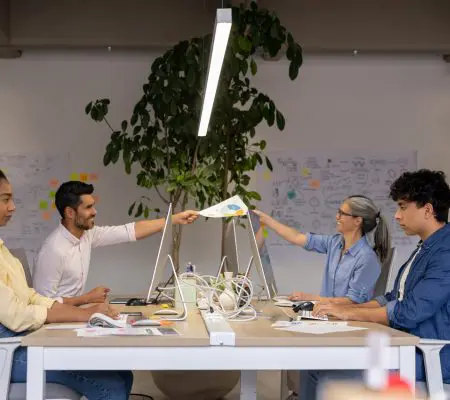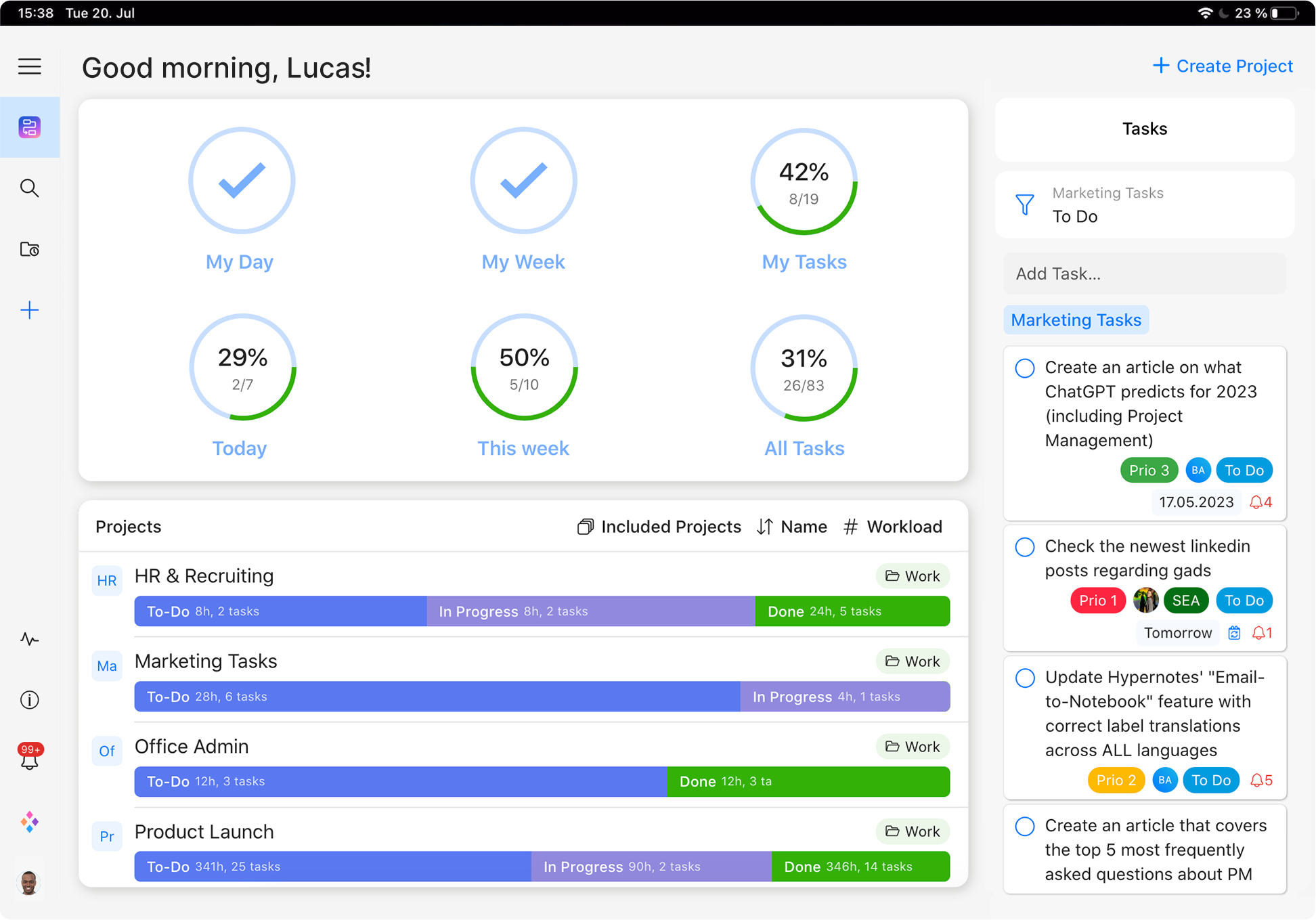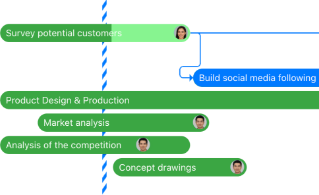
Thanks to remote work, open office plans, and shared coworking spaces — cubicles are out, and hot desking is officially “in.”
And it’s more than just a trend, unlike the matcha latte you grab on your way to work.
Embraced by startups and well-established companies, this flexible seating solution allows people to work where and when they want within the office.
But what exactly is hot desking, and why is it taking over office environments in 2025?
In this article, we’ll explore what hot desking is and the benefits it can bring to your workplace.
Let’s dive in.
What Is Hot Desking?
Do you remember the days in elementary school when you had an assigned seat in the classroom? You’d waltz into class every morning and head to the same seat — likely the farthest away from your best friend.
And every day, you’d beg your teacher to switch it up (crossing your fingers that you could finally sit near your friends to chit-chat about all the playground gossip).
You likely didn’t know it then, but you secretly wished for the hot desking seating strategy. And now that you’re all grown up, your wish is coming true in the office environment.
Hot desking is a flexible office arrangement that allows employees to use any available workspace rather than having a dedicated desk or workstation.

In other words, it’s a workspace management approach that eliminates the idea of fixed workstations in the office. Instead, employees can work at any available desk, table, or even a couch.
Hot desking gained popularity post-pandemic as businesses turned to a hybrid workplace to cater to changing work dynamics and employee preferences.
And with people rotating in and out of the office on different days of the week, companies decided to downsize their office space to save on costs.
The result? Less large, bulky, expensive desks to buy and hold on your balance sheet. And smaller (read: cheaper) workspaces with flexible seating options.
6 Benefits of Switching to Hot Desking in Your Office
Goldman Sachs, one of the top investment banks in the world, uses hot desking across some of their major United States offices instead of cubicles.
But why?
Let’s dive into some of the main benefits of adding hot desking to your office environment.
1. Increase Collaboration
Although they were originally intended to make offices more open and efficient in the 1960s, the creator of cubicles, Robert Propst, came to regret the invention.
Despite the initial promise of increased mobility and collaboration, cubicles have become synonymous with isolation and a lack of creativity in the modern workplace.

And it’s easy to see why. The high walls separate individuals from their colleagues.
While design can help limit distractions, it also creates a sense of isolation and hinders collaboration. The physical barriers make it difficult for employees to interact and collaborate with one another, which can lead to a lack of communication and a siloed working culture.
Not to mention that employees may feel less inclined to interact with their colleagues due to the perceived sense of privacy and the need to focus on their work.
By contrast, hot desking and open-plan office designs encourage employee collaboration and interaction.
Removing physical barriers and allowing employees to work close to one another creates a sense of community and encourages a more collaborative work culture. Think of it like an open-door policy.
Hot desking also allows employees to work alongside different team members, promoting cross-team collaboration and idea-sharing.
Sometimes all it takes is a new perspective to help spark creative thinking among colleagues. That’s why many tech leaders have leaned toward hot desking in their office environments.
Steve Jobs once said, “If a building doesn’t encourage collaboration, you’ll lose a lot of innovation and the magic that’s sparked by serendipity.”

Discover the ultimate collaboration tool.
Sign up for free today!
2. Foster Creativity
Have you ever noticed how workplaces often ask their employees to “think outside the box,” yet they’re stuck working in a literal box all day?
It’s kind of ironic, don’t you think? If you’re trying to foster innovation and disrupt old patterns, you need an environment where new ideas can take root and flourish.

It doesn’t matter if your employees are designing business cards or brainstorming for your next big idea. The right office environment inspires creativity and encourages collaboration.
Employees can avoid falling into routines, think more creatively, and leave their comfort zones by changing their work environment. And that’s where hot desking shines.
It allows employees to move around the office to find the most conducive environment to work in. Sometimes all it takes is a scenery change to boost creativity and bring a fresh perspective to the table.
3. Cost Savings
Inflation is at an all-time high. Companies are laying off workers left and right. And the United States economy is on the brink of an economic recession.
That means saving costs and sticking to a strict budget is crucial to surviving these challenging times.
With hot desking, you can optimize your office layout and reduce the cost of expensive cubicles and desks for every headcount.
For example, a team of ten employees may only need eight desks on any given day because some might be working from home or on vacation.
That means your HR team only needs to purchase eight instead of ten desks, saving money by omitting two that are likely to remain empty regardless.
Not only does this create a more flexible and efficient workspace, but it can also lead to significant cost savings for your company. Rather than prematurely expanding or moving to a larger office space, you can maximize your current space or downsize to avoid unnecessary expenses.
4. Health Benefits
It’s common for many of us to spend a significant amount of time sitting down every day, with some studies suggesting that over 50% of people sit for more than six hours each day.
However, the effects of prolonged sitting can be far from benign and can have both short- and long-term impacts on our health and well-being.
In fact, sitting for extended periods can increase the risk of certain health problems, making it important to be mindful and encourage your employees to move throughout the day.

Since the COVID-19 pandemic, improving your health has become a top priority for people. So adapting a seating arrangement that promotes healthy initiatives is a wise choice to keep your employees’ mental and physical health at the forefront.
Hot desking allows employees to move around the office and avoid sitting in the same chair for extended periods. It can also encourage employees to be more active and social, as they move around the office to find an available desk.
Movement is medicine. Cubicles encourage stagnation, while hot desking encourages movement in the office.
5. Flexibility
Think of hot desking like a choose-your-own-adventure workspace. So whether you need peace and quiet or want to work collaboratively with others, hot desking lets you find the perfect spot for the work day.
So if your C-suite is in the middle of deciding on the perfect HRIS system to streamline hiring and onboarding, they might choose a conference room for the day.
If your marketing team is working on content planning, they could go for a cluster of desks near each other for optimal collaboration. The opportunities are endless.
And get this — hot desking doesn’t just appeal to in-office employees. Even if you have a team of remote workers, they can come into the office when they’re in town and enjoy time at a hot desk for the day.
It’s a great way for them to mix things up and have a change of scenery. Plus, it’s a great opportunity to catch up with colleagues and make new connections.
6. Improve Company Culture
As demographics change, you need to adopt new strategies to attract and retain top talent.
And your workspace plays a critical role in this effort, as it reflects your company culture and impacts the effectiveness of your collaborative processes.

For prospective employees, your workspace can reveal whether your business values innovation, creativity and collaborative work culture.
And for current employees, the office environment directly affects job satisfaction and their ability to interact with colleagues and innovate.
Investing in a flexible workspace that promotes collaboration and cross-functional teamwork can attract and retain employees from diverse demographics and foster a more dynamic and inclusive work environment.
Final Thoughts
Hot desking is becoming increasingly popular as businesses look for ways to optimize office space and foster employee collaboration.
With hot desking, your employees can choose where they work, increasing creativity and reducing stress levels — resulting in higher collaboration, cost savings, and overall health benefits. It’s a win-win for your bottom line and employee morale.
But if you’re considering switching to hot desking, it’s important to communicate with your employees about the change. You don’t want to leave anyone out of the loop.
Once you make the switch, you’ll never look back.
About the author: Kelly Moser is the co-founder and editor at Home & Jet, a digital magazine for the modern era. She’s also an expert in freelance writing and content marketing for SaaS, Fintech, and e-commerce startups.





Leave a Reply